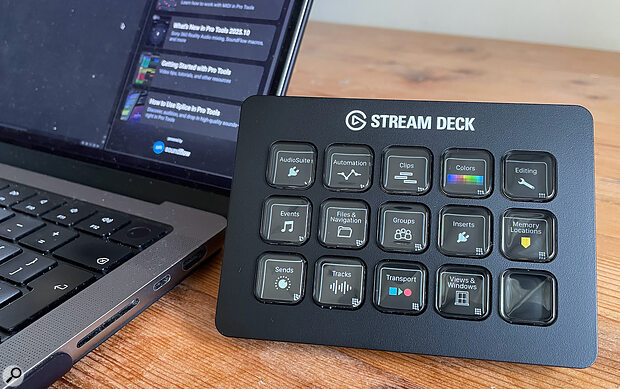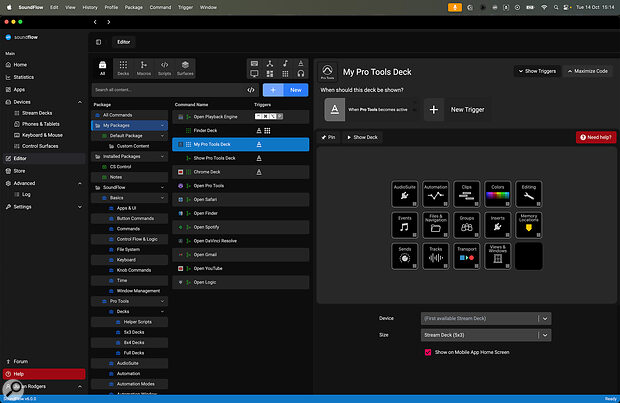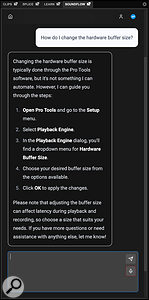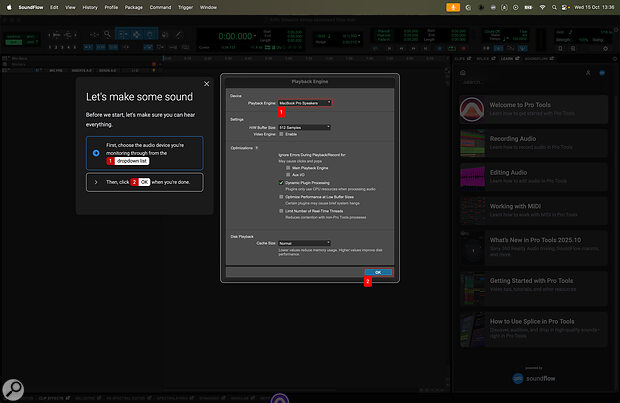 SoundFlow 6 is now fully integrated into Pro Tools, where its UI elements appear in the Clips List.
SoundFlow 6 is now fully integrated into Pro Tools, where its UI elements appear in the Clips List.
A ground‑up reinvention turns SoundFlow from an advanced macro engine into an intelligent, context‑aware virtual assistant.
Since its introduction in 2017, SoundFlow has grown from a clever macro utility for Pro Tools into a fully featured automation environment. Its user base includes many working professionals who value its flexibility, problem‑solving power, and the active online community that supports users through issues, answers questions and shares workflows.
Originally developed by engineer Christian Scheuer to automate repetitive tasks in Pro Tools, SoundFlow exploited the Accessibility features in macOS to trigger custom commands and build macros. Its roots in real‑world editing and mixing workflows explain why it has always been strongly aligned with Pro Tools. But despite that close association, it was never limited to that DAW: SoundFlow also offers official support for other applications such as Ableton Live, Logic Pro, iZotope RX, Sibelius and Media Composer, which can benefit from pre‑made commands and ‘decks’ in the same way as Pro Tools.
SoundFlow can be used to create automation for any software on the Mac, and there is an active community of users creating and sharing their custom solutions online. However, if a piece of software has not implemented macOS Accessibility features, then automation is limited. It can also be used for more mundane desktop tasks — for example, launching web pages or switching apps at the touch of a button.
This breadth of potential has long been one of SoundFlow’s greatest strengths. Its openness comes at the cost of initial complexity, but also opens the door to almost unlimited customisation. Many users build bespoke control decks, shortcuts and workflows to automate nearly every aspect of their daily computer work — from session setup to deep editing, from batch processing to web launcher decks of their most‑used pages and tools.
Version 6 marks a clear step change. It builds on that deep base of user‑driven automation and the tight partnership with Pro Tools, and then reimagines how automation can support creative work. With a new engine, new ways to build solutions, and the use of AI, SoundFlow 6 feels not just like a more powerful tool, but a more capable assistant: one that understands context, adapts to session needs, and helps users get more done with less friction.
User Perspective
I’ve been using SoundFlow since version 5, which also represented a significant deepening of capability compared to earlier versions. Whereas prior editions were useful primarily for repetitive keystroke automation, SoundFlow 5 introduced pre‑built scripts, macros and decks that substantially changed how you could work in Pro Tools. As part of this, the SoundFlow team collaborated with Avid to deliver a curated package of pre‑built macros to Pro Tools users, effectively offering more sophisticated alternatives to standard Pro Tools keyboard shortcuts.
However, the real instant impact in workflow comes from SoundFlow’s decks: grids of custom buttons that you can trigger from a touchscreen device such as an iPad or, more effectively, from a hardware controller such as a Stream Deck. Even without creating your own custom content, you can immediately access powerful commands and workflow enhancements.
 As before, SoundFlow 6 is fully integrated with hardware controllers such as Stream Decks.
As before, SoundFlow 6 is fully integrated with hardware controllers such as Stream Decks.
The SoundFlow app’s built‑in usage‑tracking statistics make its value very clear. After moving from a touchscreen‑only setup to a dedicated Stream Deck, my use of SoundFlow increased dramatically. The tactile feedback, visual cues and context‑aware displays on each Stream Deck button combine the best of hardware and software design. If you’re serious about workflow efficiency, buying a Stream Deck pays dividends quickly.
Part of what makes this easy is the pre‑built, bundled SoundFlow content for Pro Tools users. Unlike the earliest versions, where the emphasis was on installing your own macros, the packaged content means you can be productive immediately. You don’t have to start from scratch. Users have shared their own decks and macros for years, but having pre‑installed, ready‑to‑go content essentially eliminates the learning curve for many.
That said, for a technically minded user, SoundFlow’s depth remains both enticing and frustrating: you could, if you wanted, build everything yourself, and go deep into scripting, custom commands and detailed workflows. You probably never will learn all of it, but that’s not a workflow problem — it simply means that the tool has far more to give when you want it to.
SoundFlow In Pro Tools
In earlier versions, SoundFlow always operated as a parallel layer alongside Pro Tools. With version 6, for the first time, SoundFlow is embedded within Pro Tools itself. Controls, decks and commands are located where they belong: front and centre, in your DAW, and immediately accessible to every user.
In terms of user uptake, one of the most significant changes in version 6 is that you no longer need to install SoundFlow separately. It is now installed by default with Pro Tools 2025.10. The onboarding process has been stripped of friction: there are no extra downloads, no external installers, no separate login screens.
For new users, account creation and login happen directly from inside Pro Tools, using either a dedicated SoundFlow account or your existing Avid credentials. Immediately, you get access to pre‑installed decks (grids of buttons to access commands), as well as very instructive built‑in tutorials. For existing SoundFlow users, the transition is easier: there’s no longer a need to manually install the app.
Inside Pro Tools, SoundFlow is accessed from a tab located in the Clips List sidebar. From here you can launch decks of commands or macros, or detach them into floating windows which can be placed on another screen if desired; use the search bar to find commands, macros or decks by name; and discover and run the new non‑deterministic sequences called Flows, of which more later.
Triggering SoundFlow actions isn’t limited to clicking buttons in decks: you’ve always been able to assign keyboard shortcuts, MIDI events, OSC messages or even EuCon input. SoundFlow intercepts and handles key presses before they reach Pro Tools, so takes priority over Pro Tools’ own keyboard shortcuts. Because Pro Tools’ Keyboard Shortcuts window is searchable, it’s relatively easy to avoid conflicts: before assigning a shortcut in SoundFlow, check whether the key is already used, and if so, whether that use matters to you if you sacrifice it. The built‑in visual keyboard map helps with this.
Another strength is that your SoundFlow settings live in the cloud. This means that on guest systems or different machines, you simply log into your SoundFlow account and your custom shortcuts, decks and Flows follow you. A corresponding down side is that SoundFlow requires an active Internet connection. For most users, especially in music or general post workflows, this isn’t a major barrier. In highly restricted or offline environments, SoundFlow does offer solutions, but added complexity may be a consideration.
The Heart Of It
SoundFlow actions in version 6 look and feel faster and smoother than before. In earlier versions, they often visually replayed menu navigation and UI interaction, so you could see what was happening. In version 6, they often execute in the background or invisibly. The results are faster, more fluid and less visually distracting.
For deeper tasks like creating your own commands, writing scripts and editing decks and Surfaces, the full SoundFlow application and editor remain available. Pro Tools 2025.10 installs these components in the background along with the bundled content. From the menu bar you can launch the SoundFlow editor to undertake customisation, scripting or complex controller builds. Custom control layouts called Surfaces are available to power users, though casual users will never need to create them.
Importantly, many of the valuable benefits of SoundFlow can now be accessed without ever opening the editor. This significantly reduces the barrier to entry. Expert users still get full control, but non‑technical users can start right away and reap real productivity gains.
In short, SoundFlow 6 is no longer a bolt‑on adjunct. It feels native to Pro Tools. It is accessible from the moment you open a session. It integrates deeply, adapts to your workflow, and offers both simplicity for newcomers and depth for power users.
SFX
In previous versions of SoundFlow, mouse clicks, menu navigation, key presses and UI control were all triggered via operating system Accessibility hooks. That meant that SoundFlow was inherently Mac‑only. Version 6 is built instead on a new underlying engine called SFX. SFX is a framework developed by SoundFlow and it replaces, though does not eliminate, the older Accessibility‑based approach. Existing macros remain compatible, so long‑time users needn’t fear breaking their workflows. But SFX offers a fundamentally different and deeper way of interacting with applications.
 The SoundFlow Editor remains Mac‑only at present, but in other respects, SoundFlow 6 is now cross‑platform.
The SoundFlow Editor remains Mac‑only at present, but in other respects, SoundFlow 6 is now cross‑platform.
When I first heard about SFX, I assumed it was built on top of Avid’s SDK for Pro Tools, but it isn’t. It uses a different communication method that can be used to automate any supported application. The result is both higher performance and greater fluidity. Some actions execute without noticeable UI animation, and tasks complete more cleanly. And because SFX does not depend on macOS Accessibility, Windows users are no longer excluded, although at the time of writing, the full SoundFlow editor for creating custom scripts, decks and Surfaces is only available on macOS. Windows support is expected to follow.
In practice, SFX unlocks the potential for automation that is non‑deterministic, content‑aware and context‑sensitive. In earlier versions, you fired a macro, and it ran the same sequence of steps every time. With SFX, automation can react to what’s actually in your session: it can make decisions, adapt, or ask you for clarification before proceeding.
Because of this, I believe SFX is not merely a technical upgrade, but a new foundation for how automation can operate in professional audio. The potential is there for SFX, rather than any single deck, command or feature, to be the long‑term legacy of SoundFlow 6.
SFX can work with any application, but needs to be implemented at the code level by the developer. Pro Tools is the first to integrate SFX into its codebase, but a significant number of other companies have expressed an interest, and the first plug‑in integrations are expected early next year, with more to follow. A turnkey integration for some of the more common frameworks used by plug‑in developers already exists, making plug‑in support more easily achievable for developers who use these frameworks, and with Pro Tools, Live and particularly Logic all on board with SFX, it’s realistic to speculate that DAWs such as Cubase, Studio One and Reaper might follow soon.
SoundFlow AI & Flows
The new SFX engine in SoundFlow 6 provides speed, stability and cross‑platform compatibility. But what’s the headline new feature? The one that changes what SoundFlow actually is? That has to be Flows.
As already outlined, SoundFlow 6 moves beyond deterministic automation — the fixed, step‑by‑step execution of scripts and macros — and introduces non‑deterministic, context‑aware automation sequences capable of making intelligent decisions. In other words, Flows can respond to the situation they’re presented with, rather than simply replaying the same routine every time.
Unlike macros, scripts and earlier SoundFlow automation, Flows are adaptive, content‑sensitive and responsive. Their behaviour changes depending on where they’re used and what material they’re working with. They can even react to user actions in real time, adjusting their next steps based on what the user does or the data they encounter. SoundFlow 6 includes several example Flows that make the difference immediately clear.
For example, the Best Mic Flow analyses multiple microphone recordings of the same source and selects the best capture based on quality rather than level. Instead of treating the loudest track as the best, it uses AI to evaluate clarity and separation, assigning the cleanest takes to each mic. This goes far beyond what could be achieved with gates, expanders or basic scripting.
Upload to Cloud demonstrates how Flows can manage routine, multi‑step tasks. It uses a conversational interface to guide you through exporting audio, configuring routing, and sending the result to a cloud service. Once complete, it can even import timestamp comments from the remote service back into your Pro Tools session as markers.
Session Assistant shows the potential of conversational, AI‑assisted interaction. It uses either typed or voice input to carry out session setup tasks such as creating and naming tracks and moving tracks into track folders. If it needs clarification, it asks, and as it performs actions it shows them on screen, allowing the user to learn by watching. This dual purpose, as both automation and education, is a subtle but important change. It means SoundFlow isn’t just doing things for you; it’s showing you how they’re done.
 Session Assistant is an AI‑based Flow that can respond to natural‑language prompts.
Session Assistant is an AI‑based Flow that can respond to natural‑language prompts.
Session Assistant has launched with a limited feature set, but this will grow over time. SoundFlow say this growth will be prioritised based on user feedback as much as possible. At present the skills it possesses are focused on track management and control, and playback control. Of course, as it uses a chat‑based interface, you can just ask it what its skills are and it will list them. If you ask it to do something outside its current skills, it will offer guidance on how to do it instead.
These examples are early indications of what Flows can achieve. In use, it’s not perfect, but this is a very early implementation and experience tells us not to draw conclusions about AI too early. It gets better very quickly so I’m not going to focus on things it can’t do today. Just as the SoundFlow ecosystem of commands and decks has grown organically through community sharing, new Flows will continue to appear over time. Because Flows are adaptive and content‑aware, the range of possible uses is far broader than any system of fixed macros could offer.
The implications go beyond convenience. Flows represent a conceptual shift, changing SoundFlow from tool to assistant. They demonstrate how AI can enhance creative processes without undermining user control, handling repetitive, rule‑based work while leaving the creative decisions in human hands. For experienced users, that means less friction and more focus. For newcomers, it means immediate contextual help inside the DAW.
Conclusion
SoundFlow’s integration within Pro Tools marks a significant shift. SoundFlow is no longer an external utility sitting alongside the DAW. It’s now part of the application itself. While technically still optional, it now lives where it belongs; inside Pro Tools, at your fingertips. The significance of that can’t be overstated.
The most impressive element of this release is SFX. It isn’t a refinement, but a complete re‑engineering of how automation happens. It’s faster, and opens up possibilities that even experienced users may not yet fully grasp. SFX feels like the foundation of something much bigger: the technology on which new intelligent, adaptive automation can be built. From everything I’ve seen, it’s both elegant and powerful.
Flows sit on top of that foundation and showcase the possibilities. While macros, scripts and decks from SoundFlow 5 were already invaluable, Flows belong to a different category entirely. They feel like the future. It’s a shift from faster execution to intelligent assistance.
Equally importantly, SoundFlow 6 extends what already works, without breaking compatibility or alienating established users. Professionals depend on stability, and SoundFlow’s developers clearly understand that progress should never come at the expense of backward compatibility. SFX can be invoked within existing scripts by adding a single line of code, which illustrates how carefully the transition has been managed. There’s no arbitrary divide between pre‑SFX and post‑SFX workflows: just continuity and growth.
For new users, onboarding has never been easier. Many of us have encountered excellent technologies that never became part of our day‑to‑day practice simply because they required effort to adopt. By being embedded directly in Pro Tools, SoundFlow 6 sidesteps that problem. It’s right there, visible and available, and once people try it, it’s likely to stay in use.
Describing what SoundFlow does is like trying to explain what a computer was for in 1982.
Of course, no tool this flexible is easy to explain. Describing what SoundFlow does is like trying to explain what a computer was for in 1982. The only honest answer is “What do you want it to do?” That breadth can be both its strength and its frustration. It’s so open‑ended that even long‑term users may never explore all of it — but that’s not a failing. The point isn’t to master every part, but to find the parts that make your own work easier, faster and more consistent.
There will always be users who resist adaptive automation, preferring to remain entirely hands‑on. And that’s fine. Nothing in SoundFlow 6 is compulsory. In the same way that some engineers still prefer to work on tape and consoles, there’s room for every approach. But for most professionals working in modern post or music production, SoundFlow now represents a better way to interact with the tools we already use.
In final assessment, SoundFlow 6 is one of the most significant and potentially transformative developments in the way we interact with our DAWs in years. It feels like an evolution that, in hindsight, seems inevitable yet it’s still remarkable in its depth and execution. I don’t say that lightly. I see many new products; very few impress me, and fewer still surprise me. SoundFlow 6 has done both. Its scale and potential are enormous, and I suspect we’re only beginning to glimpse what it will make possible.
Pricing & Tiers
SoundFlow 6 is available in four distinct tiers, scaling from casual use to full professional integration. For Pro Tools 2025.10 users, SoundFlow is included at no additional cost courtesy of the new Free tier. This pre‑installed version provides access to bundled decks, tutorials and basic automation features. While it omits some of the more advanced capabilities of the paid plans, such as Stream Deck integration, it remains genuinely useful, with over 1700 commands available from the SoundFlow panel and the ability to assign custom keyboard and MIDI triggers to those commands in the SoundFlow Editor.
The first paid‑for tier is SoundFlow AI, priced at $10 per month or $100 per year, which introduces the AI‑driven features and Flows. Like all cloud‑based AI services, these functions carry real computational and energy costs, so it feels reasonable that access is subscription‑based. SoundFlow Pro, at $12 per month or $120 per year, corresponds to the full‑featured edition familiar to long‑time users, including scripting, macro creation, Surfaces and integrations with Stream Decks, phones and tablets. Finally, SoundFlow Pro AI, the flagship plan at $20 per month or $200 per year, combines every feature from both Pro and AI tiers.
Existing subscribers retain their current pricing and feature sets, ensuring continuity for legacy users.
Tutorials & Learning
As described in the main text, the Session Assistant Flow can be instructive for new users because it doesn’t just perform tasks, it shows you how they’re done. That concept has also been developed in SoundFlow 6 and Pro Tools 2025.10 to deliver an entirely new style of tutorial system. Traditional linear video walkthroughs remain part of the package, and in some cases, a one‑way video demonstration is exactly what’s needed. But video training can only ever show one example, at one pace, with one outcome.
The new SoundFlow‑powered tutorials take a completely different approach. They are interactive and built on SFX‑based Flows, meaning they are dynamic, adaptive and capable of responding to what you do inside your own active Pro Tools session. Rather than watching a video of someone else using Pro Tools, you can learn in Pro Tools, with the software itself guiding you through each step.
From the Learn tab in the Clips List sidebar, you can access a collection of both linear video and interactive Flow‑based tutorials. Examples of the latter include a Getting Started tutorial and Flows on recording and editing audio and working with MIDI. Because these tutorials are driven by the same Flow technology that underpins automation in SoundFlow 6, they can interact directly with the interface. They can highlight the correct menu, prompt you to click or select an item, wait for your action before proceeding, and even adjust the next instruction depending on what you actually do. If you make a different choice, the tutorial adapts accordingly.
As someone who has worked as a software trainer, I find this development remarkable. One of the core challenges in teaching any complex application is that every learner progresses at a different pace. Video lessons move at a fixed speed. Manuals assume prior understanding. But an adaptive tutorial proceeds in step with the learner. It teaches by doing, not by showing: a principle that any effective teacher recognises as crucial to genuine understanding.
 Flows also power educational content in Pro Tools.
Flows also power educational content in Pro Tools.
These interactive tutorials are already being used to support onboarding for new Pro Tools users. They guide you through basic setup: how to get sound from your interface, how to route tracks, how to record, and how to navigate the Pro Tools environment. For me, this is one of the most exciting developments in SoundFlow 6. Flows are impressive as automation tools, but their application in teaching represents something genuinely new. This is a training system that behaves like a knowledgeable assistant, embedded within the DAW, responding to your actions and guiding your progress. For newcomers, it could transform the learning process. For experienced users, it demonstrates just how flexible the underlying SFX and Flow technologies really are.
Pros
- Deep integration in Pro Tools, with no separate install or setup.
- New SFX engine enables powerful features and Windows support.
- AI‑driven Flows enable adaptive, context‑aware automation and chat‑based interfacing.
- Interactive tutorials hugely improve onboarding and learning.
- Retains compatibility with existing SoundFlow 5 scripts and workflows.
Cons
- Learning curve remains steep for advanced customisation.
- SoundFlow Editor currently unavailable on Windows at launch.
- Fully realising its potential requires SFX implementation by third parties.
Summary
SoundFlow 6 marks a major step forward for workflow automation in Pro Tools and beyond. The new SFX engine, cross‑platform capability, and AI‑driven Flows take SoundFlow’s possibilities far beyond previous versions. What it can do today is impressive, but the potential it opens up for future development is huge.
Information
See ‘Pricing & Tiers’ box.
See ‘Pricing & Tiers’ box.
